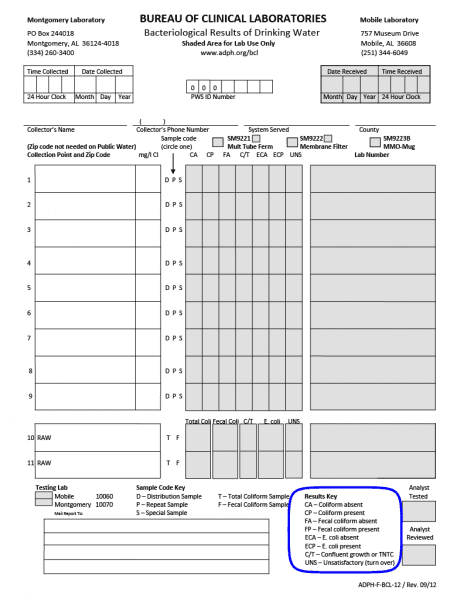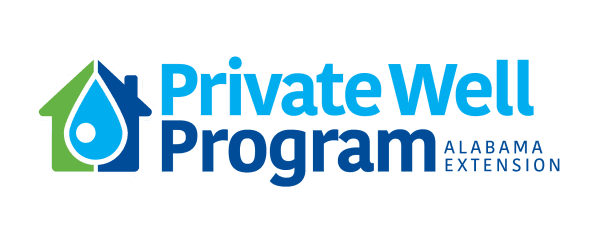Fish & Water

Water testing gives an overall picture of general well health. After going through the process of sampling and testing the water, it is time to interpret the results.
Features of a Bacteriological Report Given by the Alabama Department of Public Health

Alabama Department of Public Health Result Form
Available at https://www.alabamapublichealth.gov/bcl/sanitary-bacteriology.html.
The Alabama Department of Public Health (ADPH) only offers bacteriological testing, so if more extensive water testing is required, well owners should contact a certified private laboratory. If people decide to test their water with the ADPH, a result key will be provided on the bottom right corner of the sample results form. The following acronyms are found in this results key:
- CA – Coliform Absent
- CP – Coliform Present
- FA – Fecal Coliform Absent
- FP – Fecal Coliform Present
- ECA – E. coli Absent
- ECP – E. coli Present
- C/T – Confluent Growth or Too Numerous to Count
- UNS – Unsatisfactory
What does this mean?
If results are given that show the presence of coliform (CP), fecal coliform (FP), or E. coli (ECP), it means that the sample tested is positive for these bacteria per 100 mL of water. Follow-up action is required in these cases, and individuals should contact their county health department office immediately.
If the form indicates confluent or too numerous to count (C/T), a high number of bacteria are present in the sample. These bacteria may mask underlying coliform bacteria, and the sample should be recollected and tested again.
Unsatisfactory results (UNS) require further clarification from the laboratory. If the sample sheet reads unsatisfactory, call the laboratory that completed the test for an explanation. Some sample codes for unsatisfactory tests will be provided on the back of the results form.
Features of a Sample Report From a Private Lab
Once the lab has completed the testing process for the well water, owners should receive a report. Most labs will compare the test results to the Maximum Contaminant Level (MCL) set for public water systems by the EPA. Read about these guidelines in EPA Drinking Water Guidelines on the Alabama Extension website. Even though these levels are not enforced for private well owners, this comparison to EPA guidelines allows owners to assess where the well’s water quality falls on the health spectrum. Results may be reported in the following units:
- Parts per million (ppm)
- Parts per billion (ppb)
- Micrograms per liter (μ/L)
- Milligrams per liter (mg/L)
- CFU/ 100 mL (for bacterial tests)
The general format of the lab sheet will differ depending on where the sample is tested. However, each sheet should have a section for the owner’s name, county, and the date and time of the sample collection. Always keep a copy of the test results for future reference.
Interpreting Results
Bacteriological Tests
It is nearly impossible to test for every disease-causing bacteria that may occur in water. Instead, a test for total coliform bacteria is performed to determine the presence of bacteria, parasites, and pathogens in water. These bacteria are typically found in the digestive tract of warm-blooded animals and are generally not harmful to humans (with a few exceptions). The United States Environmental Protection Agency (EPA) considers total coliforms a useful indicator of other pathogens for drinking water, and subsequent testing should be done to determine the presence of harmful fecal bacteria such as E. coli O157:H7.
A general report will indicate whether or not coliform bacteria are present in the water. If coliform bacteria are detected in the water sample, owners should have another sample tested. If the second test shows bacterial contamination, begin inspecting the area around the well for any potential sources of contamination. Owners should ask themselves the following questions:
- Is the well cap or seal on tightly?
- Is the wiring in tact?
- Does the casing extend one foot from the ground?
- Is the well in a depression or pit?
- Has the pump been removed recently?
What if you have E. coli in your water?
E. coli is generally not harmful to humans, and most strands can live in the intestines of healthy humans and animals. However, a specific stand of E. coli (O157:H7) can lead to illness. E. coli can be found on livestock farms, where the bacteria can live in the stomachs of warm-blooded animals. Feces contaminated with pathogenic E. coli can enter your water source in several ways, including via stormwater runoff or from agricultural runoff. To find out if there is pathogenic E. coli in the water, contact a certified laboratory to run a test on the water.
Chemical Tests
Results from chemical tests are usually expressed in parts per million (ppm) or milligrams per liter (mg/L). Compare the results to the MCL and SMCL standards set by the EPA. Any parameter that exceeds the MCL should be treated.
Mineral Tests
Typical mineral tests give the concentration in parts per million (ppm). These tests will generally give results for things like calcium, magnesium, manganese, iron, copper, and zinc. Mineral tests also determine the acidity or pH of the water and its hardness. Compare the results to the MCL and SMCL standards set by the EPA.
Common Testing Parameters
- Nitrate. A form of nitrogen that can dangerously affect blood-oxygen levels. Some sources of nitrate may be fertilizer, septic systems, and animal waste.
- Lead and copper. Lead and copper can be leached into water from plumbing fixtures. High lead levels can be especially dangerous to young children, infants, and pregnant women.
- Alkalinity. A measure of the ability of the water body to neutralize acids and bases and maintain a stable pH level.
- Chloride. May indicate contamination from a septic system, fertilizer, or landfill.
- Hardness. Caused mostly by dissolved calcium and magnesium.
- Corrosivity index. Indicates the tendency for water to corrode plumbing.
- Total dissolved solids (TDS). Dissolved minerals like iron or manganese. High TDS may also indicate water hardness.
When to Consider Additional Water Testing
Private well owners should consider performing additional water testing when under the following conditions:
- The owner is expecting a baby in the home.
- The well has recently been affected by a flood.
- A chemical spill occurs within 500 feet of the well.
- A person is purchasing a house with a well.
- Neighbors have recently found contaminants in their groundwater.
- The well is old or shallow.
- The well does not meet construction codes.
- The household has recently suffered gastrointestinal illness.
- A nearby development is using hazardous materials.
- The plumbing system shows signs of deterioration.
- The owner notices a change in the water’s taste, appearance, or smell.
More Information
For more information about private water wells, visit the Private Well Program section of www.aces.edu.


